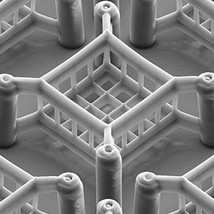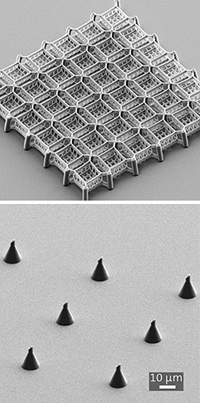/ News

Micro 3-D Printer Creates Tiny Structures in Seconds
Nanoscribe, a spin-off from the Karlsruhe Institute of Technology in Germany, has developed a tabletop 3-D microprinter that can create complicated microstructures 100 times faster than is possible today. “If something took one hour to make, it now takes less than one minute,” says Michael Thiel, chief scientific officer at Nanoscribe.
While 3-D printing of toys, iPhone covers, and jewelry continues to grab headlines (see “The Difference Between Makers and Manufacturers”), much of 3-D printing’s impact could be at a much smaller scale. Micrometer-scale printing has shown promise for making medical and electronic devices.
Thiel says it should be possible to speed up his company’s microprinting technique even more in the future. Nanoscribe plans to start selling its machine in the second half of this year.

Shape making: Two scanning electron microscope images show a printed cell scaffold (top) and an array of microneedles.
Printing microstructures with features a few hundred nanometers in size could be useful for making heart stents, microneedles for painless shots, gecko adhesives, parts for microfluidics chips, and scaffolds for growing cells and tissue. Another important application could be in the electronics industry, where patterning nanoscale features on chips currently involves slow, expensive techniques. 3-D printing would quickly and cheaply yield polymer templates that could be used to make metallic structures.
So far, 3-D microprinting has been used only in research laboratories because it’s pretty slow. In fact, many research labs around the world use Nanoscribe’s first-generation printer. The new, faster machine will also find commercial use. Thiel says numerous medical, life sciences, and nanotechnology companies are interested in the new machine. “I’m positive that with the faster throughput we get with this new tool, it might have an industrial breakthrough very soon,” he says.
The technology behind most 3-D microprinters is called two-photon polymerization. It involves focusing tiny, ultrashort pulses from a near-infrared laser on a light-sensitive material. The material polymerizes and solidifies at the focused spots. As the laser beam moves in three dimensions, it creates a 3-D object.
Today’s printers, including Nanoscribe’s present system, keep the laser beam fixed and move the light-sensitive material along three axes using mechanical stages, which slows down printing. To speed up the process, Nanoscribe’s new tool uses a tiny moving mirror to reflect the laser beam at different angles. Thiel says generating multiple light beams with a microlens array could make the process even faster.
The smallest features that can be created using the Nanoscribe printer measure about 30 nanometers, says Julia Greer, professor of materials science at the California Institute of Technology.
“This is very challenging to do, and the Nanoscribe tool excels at it,” Greer says. “I don’t think there is another company out there that is capable of such precision.” Greer’s research team uses the first-generation Nanoscribe printer to create and study materials that could be used for catalysts and to make strong, lightweight structures, but she acknowledges that its slowness is a drawback.
Source: http://www.technologyreview.com/news/511856/micro-3-d-printer-creates-tiny-structures-in-seconds/
/ About us
Founded by Russian entrepreneur Dmitry Itskov in February 2011 with the participation of leading Russian specialists in the field of neural interfaces, robotics, artificial organs and systems.
The main goals of the 2045 Initiative: the creation and realization of a new strategy for the development of humanity which meets global civilization challenges; the creation of optimale conditions promoting the spiritual enlightenment of humanity; and the realization of a new futuristic reality based on 5 principles: high spirituality, high culture, high ethics, high science and high technologies.
The main science mega-project of the 2045 Initiative aims to create technologies enabling the transfer of a individual’s personality to a more advanced non-biological carrier, and extending life, including to the point of immortality. We devote particular attention to enabling the fullest possible dialogue between the world’s major spiritual traditions, science and society.
A large-scale transformation of humanity, comparable to some of the major spiritual and sci-tech revolutions in history, will require a new strategy. We believe this to be necessary to overcome existing crises, which threaten our planetary habitat and the continued existence of humanity as a species. With the 2045 Initiative, we hope to realize a new strategy for humanity's development, and in so doing, create a more productive, fulfilling, and satisfying future.
The "2045" team is working towards creating an international research center where leading scientists will be engaged in research and development in the fields of anthropomorphic robotics, living systems modeling and brain and consciousness modeling with the goal of transferring one’s individual consciousness to an artificial carrier and achieving cybernetic immortality.
An annual congress "The Global Future 2045" is organized by the Initiative to give platform for discussing mankind's evolutionary strategy based on technologies of cybernetic immortality as well as the possible impact of such technologies on global society, politics and economies of the future.
Future prospects of "2045" Initiative for society
2015-2020
The emergence and widespread use of affordable android "avatars" controlled by a "brain-computer" interface. Coupled with related technologies “avatars’ will give people a number of new features: ability to work in dangerous environments, perform rescue operations, travel in extreme situations etc.
Avatar components will be used in medicine for the rehabilitation of fully or partially disabled patients giving them prosthetic limbs or recover lost senses.
2020-2025
Creation of an autonomous life-support system for the human brain linked to a robot, ‘avatar’, will save people whose body is completely worn out or irreversibly damaged. Any patient with an intact brain will be able to return to a fully functioning bodily life. Such technologies will greatly enlarge the possibility of hybrid bio-electronic devices, thus creating a new IT revolution and will make all kinds of superimpositions of electronic and biological systems possible.
2030-2035
Creation of a computer model of the brain and human consciousness with the subsequent development of means to transfer individual consciousness onto an artificial carrier. This development will profoundly change the world, it will not only give everyone the possibility of cybernetic immortality but will also create a friendly artificial intelligence, expand human capabilities and provide opportunities for ordinary people to restore or modify their own brain multiple times. The final result at this stage can be a real revolution in the understanding of human nature that will completely change the human and technical prospects for humanity.
2045
This is the time when substance-independent minds will receive new bodies with capacities far exceeding those of ordinary humans. A new era for humanity will arrive! Changes will occur in all spheres of human activity – energy generation, transportation, politics, medicine, psychology, sciences, and so on.
Today it is hard to imagine a future when bodies consisting of nanorobots will become affordable and capable of taking any form. It is also hard to imagine body holograms featuring controlled matter. One thing is clear however: humanity, for the first time in its history, will make a fully managed evolutionary transition and eventually become a new species. Moreover, prerequisites for a large-scale expansion into outer space will be created as well.
Key elements of the project in the future
• International social movement
• social network immortal.me
• charitable foundation "Global Future 2045" (Foundation 2045)
• scientific research centre "Immortality"
• business incubator
• University of "Immortality"
• annual award for contribution to the realization of the project of "Immortality”.



 LinkedIn
LinkedIn
 LiveJournal
LiveJournal
 Google
Google
 Twitter
Twitter
 Facebook
Facebook
 Я.ру
Я.ру
 ВКонтакте
ВКонтакте
 Mail.ru
Mail.ru